Topical Advisory Panel applications are now closed. Please contact the Editorial Office with any queries.
Journal Description
Pathogens
Pathogens
is an international, peer-reviewed, open access journal on pathogens and pathogen-host interactions published monthly online by MDPI.
- Open Access— free for readers, with article processing charges (APC) paid by authors or their institutions.
- High Visibility: indexed within Scopus, SCIE (Web of Science), PubMed, MEDLINE, PMC, Embase, PubAg, CaPlus / SciFinder, AGRIS, and other databases.
- Journal Rank: JCR - Q2 (Microbiology) / CiteScore - Q1 (Infectious Diseases)
- Rapid Publication: manuscripts are peer-reviewed and a first decision is provided to authors approximately 13.5 days after submission; acceptance to publication is undertaken in 2.6 days (median values for papers published in this journal in the first half of 2025).
- Recognition of Reviewers: reviewers who provide timely, thorough peer-review reports receive vouchers entitling them to a discount on the APC of their next publication in any MDPI journal, in appreciation of the work done.
- Companion journals for Pathogens include: Parasitologia and Bacteria.
Impact Factor:
3.3 (2024);
5-Year Impact Factor:
3.6 (2024)
Latest Articles
Genetic Diversity of Highly Pathogenic Avian Influenza Viruses Isolated in Hokkaido, Japan, During Winter 2024–2025
Pathogens 2025, 14(9), 951; https://doi.org/10.3390/pathogens14090951 (registering DOI) - 21 Sep 2025
Abstract
Genetic and antigenic analyses were performed on highly pathogenic avian influenza viruses (HPAIVs) isolated in Hokkaido, northern Japan, during the winter of 2024–2025. Ninety-eight HPAIVs were isolated from feces of waterfowl, tracheal swabs from dead wild birds, or lung homogenates from dead chickens.
[...] Read more.
Genetic and antigenic analyses were performed on highly pathogenic avian influenza viruses (HPAIVs) isolated in Hokkaido, northern Japan, during the winter of 2024–2025. Ninety-eight HPAIVs were isolated from feces of waterfowl, tracheal swabs from dead wild birds, or lung homogenates from dead chickens. Phylogenetic analysis of the hemagglutinin (HA) gene from 47 representative isolates revealed that all sequences belonged to the G2d subgroup of clade 2.3.4.4b H5HA, which has been the dominant lineage in Hokkaido since the winter of 2021–2022. These isolates were further divided into three major groups within the subgroup. The HPAIVs isolated in the Republic of Korea, China, and North America were genetically closely related to the Hokkaido isolates, whereas no HPAIVs genetically related to European strains or those detected in North American cattle were identified. Furthermore, HPAIVs isolated from seabirds were genetically closely related to those found in dead marine mammals along the eastern coast of Hokkaido in the spring of 2025. No apparent antigenic differences were observed between the HPAIVs isolated in this study and those from previous seasons. These findings highlight the wide distribution of HPAIVs in Hokkaido, particularly from Asian and North American lineages, and underscore the importance of continuous surveillance.
Full article
(This article belongs to the Section Viral Pathogens)
►
Show Figures
Open AccessReview
The Impact of Helminths on Colorectal Cancer: From Infections to the Isolation of Biotherapeutics
by
Cuauhtémoc Ángel Sánchez-Barrera, Karen V. Fernandez-Muñoz, Mónica G. Mendoza-Rodríguez, María T. Ortiz-Melo, Jazmín A. Carrillo-Pérez, Miriam Rodríguez-Sosa and Luis I. Terrazas
Pathogens 2025, 14(9), 949; https://doi.org/10.3390/pathogens14090949 (registering DOI) - 20 Sep 2025
Abstract
Worldwide, colorectal cancer (CRC) is the third-most common cancer and the second-leading cause of cancer-related deaths. The inflammatory response initiated by pathogens, environmental and dietary factors, and inflammatory bowel diseases can promote the formation of colorectal tumors. The hygiene hypothesis proposes an inverse
[...] Read more.
Worldwide, colorectal cancer (CRC) is the third-most common cancer and the second-leading cause of cancer-related deaths. The inflammatory response initiated by pathogens, environmental and dietary factors, and inflammatory bowel diseases can promote the formation of colorectal tumors. The hygiene hypothesis proposes an inverse link between inflammatory diseases and early childhood exposure to pathogens, with a significant negative correlation between chronic inflammatory diseases and helminth infections. On the other hand, it is also known that several pathogens may influence or even cause the development of cancer, including helminth infections. How do helminth infections influence CRC outcomes? The existing literature presents two different perspectives. Experimental studies in CRC models suggest that helminths may accelerate disease progression and lead to worse outcomes (such as Schistosoma and Trichuris sp.), while others indicate that helminths could help reduce tumor burden (such as Taenia sp.). This review focuses on helminths’ pro- and anti-tumorigenic effects and their derivatives, specifically in CRC. We provide a comprehensive understanding of how helminths impact the macroscopic, histopathological, immunological, and molecular aspects of CRC.
Full article
(This article belongs to the Special Issue Immunity and Immunoregulation in Helminth Infections)
►▼
Show Figures

Graphical abstract
Open AccessReview
Structure and Functions of Actin and Actin-Binding Proteins in Leishmania
by
Chhitar M. Gupta and Saravanamuthu Thiyagarajan
Pathogens 2025, 14(9), 948; https://doi.org/10.3390/pathogens14090948 - 19 Sep 2025
Abstract
The actin cytoskeleton plays a crucial role in fundamental eukaryotic processes such as morphogenesis, motility, endocytosis, intracellular trafficking, and cell division. However, our understanding of actin and its associated proteins in trypanosomatid parasites like Leishmania remains limited. Over the past two decades, considerable
[...] Read more.
The actin cytoskeleton plays a crucial role in fundamental eukaryotic processes such as morphogenesis, motility, endocytosis, intracellular trafficking, and cell division. However, our understanding of actin and its associated proteins in trypanosomatid parasites like Leishmania remains limited. Over the past two decades, considerable progress has been made in elucidating the structure and functions of Leishmania actin and its core regulators. Notably, these findings are primarily derived from studies of the insect-stage promastigote form, while the roles of the actin machinery during the disease-causing amastigote stage within mammalian hosts remain largely unexplored. This review consolidates the current knowledge of actin and its interactors in Leishmania promastigotes, highlighting their potential roles in parasite development and stage-specific differentiation. Additionally, it explores the potential of targeting the cytoskeletal system as a strategy for novel therapeutic interventions against Leishmaniasis. The review concludes by identifying critical knowledge gaps and proposing future research directions to better understand actin-driven pathogenesis in this important human parasite.
Full article
(This article belongs to the Special Issue Leishmania & Leishmaniasis)
►▼
Show Figures
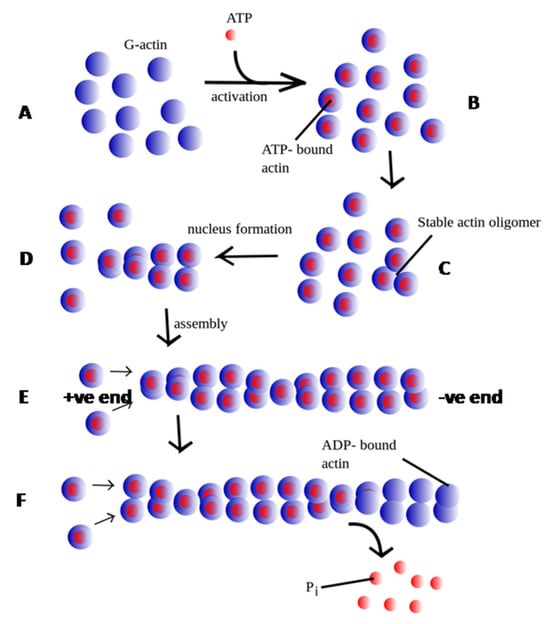
Figure 1
Open AccessArticle
Immunogenicity of SARS-CoV-2 mRNA Vaccine in Breast Cancer Patients Undergoing Active Treatment: A Prospective Observational Study
by
María Leonor Fernández-Murga, Lucía Serrano-García, Giuseppe D’Auria, María Portero Hernández, Llúcia Martínez-Priego, Loreto Ferrús-Abad, Griselda de Marco, María Victoria Domínguez-Márquez and Antonio Llombart-Cussac
Pathogens 2025, 14(9), 947; https://doi.org/10.3390/pathogens14090947 - 18 Sep 2025
Abstract
Understanding the immune response to SARS-CoV-2 vaccination in cancer patients remains a critical priority given their immunocompromised status. In this prospective observational study, we evaluated humoral and cellular immunity across three time points—baseline, post-second dose, and post-booster—in 23 breast cancer patients undergoing active
[...] Read more.
Understanding the immune response to SARS-CoV-2 vaccination in cancer patients remains a critical priority given their immunocompromised status. In this prospective observational study, we evaluated humoral and cellular immunity across three time points—baseline, post-second dose, and post-booster—in 23 breast cancer patients undergoing active treatment. IgG antibody levels showed a significant increase following vaccination, with a 300-fold rise after the second dose and a 2200-fold increase post-booster, indicating a strong humoral response. CD19⁺ B cells also increased significantly, supporting B cell-mediated activation. Although overall T cell frequencies remained stable, we observed a shift toward memory phenotypes, with decreased naïve CD4⁺ and CD8⁺ T cells and increased central and peripheral memory subsets after the booster. Notably, CD8⁺ TEMRA cells expanded significantly, suggesting cytotoxic memory formation. Correlation analyses linked peripheral memory CD4⁺ T cells with anti-SARS-CoV-2 IgG titers, while CD8⁺ TEMRA cells showed an inverse association. Antigen-specific CD8⁺ T cell response was evaluated using APC-labeled MHC I Dextramer reagents. After the booster, 55.5% of patients developed detectable antigen-specific CD8⁺ T cells, whereas 44.5% did not. Importantly, one patient who failed to develop antigen-specific CD8⁺ T cells experienced a mild SARS-CoV-2 infection, suggesting that the absence of this response may increase susceptibility despite high IgG levels. These findings indicate that antigen-specific CD8⁺ T cell responses and antibody levels may act as complementary but not directly correlated arms of immunity. Microbiota profiling via sPLS-DA suggested weak but distinct microbial signatures associated with immune responsiveness, particularly enrichment of taxa such as Alistipes and Romoutsia among high-antibody responders. These findings emphasize that SARS-CoV-2 vaccination is immunogenic and well tolerated in breast cancer patients under therapy and highlight the need to further explore microbiota–immune interactions to optimize vaccination strategies in oncology.
Full article
(This article belongs to the Special Issue Role of Microorganisms in Breast Cancer)
Open AccessReview
Long-Term Breastfeeding: Protective Effects Against Triple-Negative Breast Cancer and the Role of the Breast Microbiota
by
Julia Sierra-Roca and Joan Climent
Pathogens 2025, 14(9), 946; https://doi.org/10.3390/pathogens14090946 - 18 Sep 2025
Abstract
Long-term breastfeeding is a modifiable, protective factor against breast cancer, particularly triple-negative breast cancer (TNBC), a highly aggressive subtype with limited therapeutic options. Recent findings suggest that the protective effects of breastfeeding are mediated not only through hormonal regulation and epithelial differentiation but
[...] Read more.
Long-term breastfeeding is a modifiable, protective factor against breast cancer, particularly triple-negative breast cancer (TNBC), a highly aggressive subtype with limited therapeutic options. Recent findings suggest that the protective effects of breastfeeding are mediated not only through hormonal regulation and epithelial differentiation but also via the modulation of the breast microbiota. This review examines epidemiological data on the association between breastfeeding duration and TNBC risk reduction, highlights the composition and functions of breast microbiota in health and disease, and discusses how dysbiosis may contribute to carcinogenesis. By examining the microbiome’s role in maintaining breast health, we emphasize how breastfeeding contributes to a natural defense system against TNBC, offering a unique perspective on the intersection of maternal health, microbiology, and cancer prevention. Breastfeeding not only provides maternal and infant benefits but also emerges as a biological strategy that promotes cancer resistance through its influence on the breast microbiota. Integrating epidemiological, microbiological, and mechanistic evidence suggests that future research deliberately combining these domains will be essential to clarify causal pathways and translate findings into prevention and intervention strategies against TNBC.
Full article
(This article belongs to the Special Issue Role of Microorganisms in Breast Cancer)
►▼
Show Figures
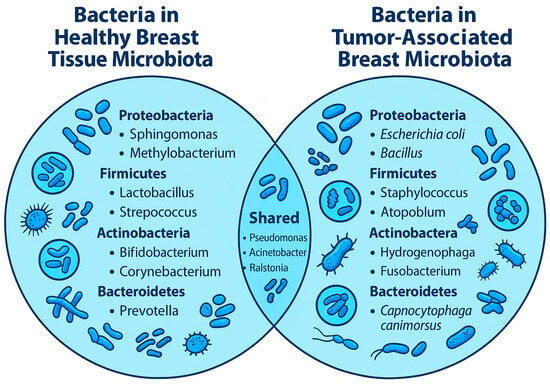
Figure 1
Open AccessArticle
The Association of Macavirus and Ovine Gammaherpesvirus 2 with Pneumonia in Beef Cattle from Mato Grosso, Brazil
by
Julia Raisa Ximenes Figueiredo, Flavia Helena Pereira Silva, Juliana Torres Tomazi Fritzen, Beatriz Martins Machado, Fernanda Pinto Ferreira, Karina Rodrigues Gomes Ferreira, Sébastien Buczinski, Amauri Alcindo Alfieri and Selwyn Arlington Headley
Pathogens 2025, 14(9), 945; https://doi.org/10.3390/pathogens14090945 - 18 Sep 2025
Abstract
This study investigated the possible occurrence of pulmonary disease in beef cattle from 13 municipalities within the State of Mato Grosso (MT), Brazil. The state of MT is a leading player in beef cattle production in Brazil, but with comparatively few data relative
[...] Read more.
This study investigated the possible occurrence of pulmonary disease in beef cattle from 13 municipalities within the State of Mato Grosso (MT), Brazil. The state of MT is a leading player in beef cattle production in Brazil, but with comparatively few data relative to the occurrence of pulmonary disease or ovine gammaherpesvirus 2 (OvGHV2)-related infections in cattle. Pulmonary samples from 44 beef cattle, with ages ranging between 18 and 28 months, were collected during slaughter and processed to determine the patterns of pulmonary lesions. Additionally, duplicate fragments were used in immunohistochemical (IHC) assays designed to detect malignant catarrhal fever (MCFV) antigens and in molecular assays to amplify 10 agents associated with the development of bovine respiratory disease (BRD). Interstitial pneumonia (IP) was diagnosed in most of the lungs (98%; 43/44) evaluated from all municipalities. MCFV antigens were detected in 37% (16/43) of the animals with IP. Only four pathogens were amplified by molecular assays within the lungs of cattle with IP: OvGHV2 (23%; 10/43), bovine viral diarrhea virus (12%; 5/43), bovine coronavirus (7%; 3/43), and Mannheimia haemolytica (2%; 1/43). The nucleic acids of bovine respiratory syncytial virus, bovine alphaherpesvirus 1, bovine parainfluenza virus 3, Pasteurella multocida, Histophilus somni, and Mycoplasmopsis (Mycoplasma) bovis were not amplified. Singular infections in cattle from municipalities were associated with MCFV (n = 3) and OvGHV2 (n = 2), while OvGHV2 occurred in all dual and triple infections. However, in four animals with IP, none of the disease pathogens identified were detected. Statistically, MCFV antigens were more frequently (p = 0.048) detected in the lungs of female (75%; 12/16) cattle with IP relative to males (25%; 4/16). Additionally, there was a positive correlation (p < 0.001) between the IHC detection of MCFV antigens within the bronchial epithelium and the epithelium of peribronchial glands of cattle with IP. This is the first study to statistically demonstrate that female cattle are at greater risk of developing MCFV-related infections as compared to male animals. The detection of OvGHV2 in singular and multiple infections during this investigation supports earlier studies that associate this pathogen with the development of pulmonary disease in cattle, indicating that OvGHV2 can contribute to the etiology of IP. Additionally, the detection of OvGHV2-induced infections in asymptomatic cattle suggests that all animals were subclinically infected, confirming that subclinically OvGHV2-induced infections may be widespread in ruminants from Brazil. Furthermore, the occurrence of atypical interstitial pneumonia cannot be discarded, particularly in animals with IP but without any associated pathogen. These initial findings suggest the need for a more elaborate investigation to understand the dynamics of pulmonary disease within this state.
Full article
(This article belongs to the Section Viral Pathogens)
►▼
Show Figures
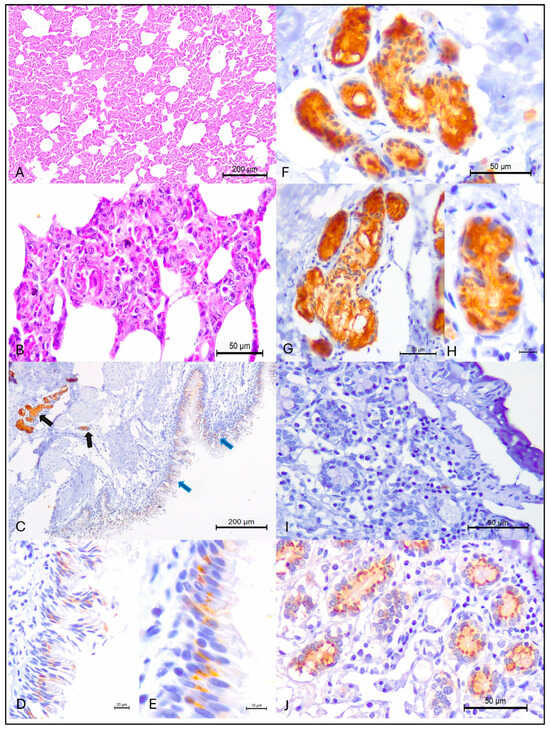
Figure 1
Open AccessArticle
SFTSV Prevalence in Ticks and Livestock in an SFTSV-Endemic Area in Central China
by
Hui-Ya Lu, Guan-Du Wu, Meng Peng, Li-Bang Wu, Yi-Ming Luo, Bin Xia, Dan Xiong, Xiang-Rong Qin, Fang Guo and Xue-Jie Yu
Pathogens 2025, 14(9), 944; https://doi.org/10.3390/pathogens14090944 - 18 Sep 2025
Abstract
Severe fever with thrombocytopenia syndrome virus (SFTSV) is an emerging tick-borne bunyavirus that causes a severe viral hemorrhagic fever (SFTS), with a very high case mortality rate, expanding epidemic areas, and increasing incidence. Due to the lack of an effective drug or vaccine
[...] Read more.
Severe fever with thrombocytopenia syndrome virus (SFTSV) is an emerging tick-borne bunyavirus that causes a severe viral hemorrhagic fever (SFTS), with a very high case mortality rate, expanding epidemic areas, and increasing incidence. Due to the lack of an effective drug or vaccine for SFTS, reducing the incidence and mortality of SFTS primarily relies on decreasing the density of ticks and the number of their host animals. However, which tick species and vertebrate animal serve as the major reservoir and animal host of SFTSV are not clearly understood. In May of 2023 and June of 2024, we collected 2437 ticks from domesticated animals and grassland in Suizhou City, a prefecture of Hubei Province in central China. A total of 195 domesticated animal blood samples were collected, including 152 goats, 26 cattle, and 17 dogs. Ticks were grouped for RNA extraction according to their life stages and feeding status. RNA from each animal’s blood and each group of ticks was extracted with an RNA extraction kit and tested for SFTSV with RT-PCR. Ticks were classified according to morphology, and representative ticks of each stage were confirmed with PCR amplification and DNA sequencing of the mitochondrial 16S RNA gene. Among the collected ticks, the majority were from goats (72.7%, 1772/2437), and Haemaphysalis longicornis was predominant, accounting for 99.47% (2425/2437), and other tick species were very rare, with 0.45% (11/2437) Rhipicephalus microplus, and 0.04% (1/2437) H. flava and Ixodes sinensis, respectively. We found SFTSV RNA in H. longicornis ticks with a minimum infection rate of 0.17% (4/2424) and in one goat (0.66%,1/152). In summary, we demonstrated that the H. longicornis tick is positive for SFTSV and that the goat is the major host of Haemaphysalis longicornis in Suizhou, central China. Our study suggests that controlling ticks on goats may play an important role in preventing SFTSV infection in China.
Full article
(This article belongs to the Special Issue One Health—Viral Zoonosis: Epidemiology, Pathogenesis, Surveillance and Early Warning, Novel Prevention and Control Technologies)
►▼
Show Figures
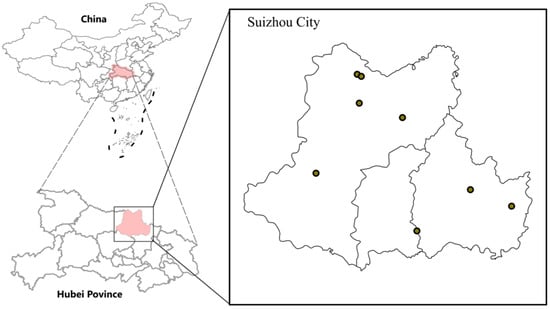
Figure 1
Open AccessReview
Microbial Quality of Leafy Greens Grown Under Soilless Production Systems
by
Robert Korir Cheruiyot and Abraham Fikru Mechesso
Pathogens 2025, 14(9), 943; https://doi.org/10.3390/pathogens14090943 - 18 Sep 2025
Abstract
This review examines the microbiological diversity and food safety implications of soilless production systems, particularly aquaponics and hydroponics, which are gaining popularity as efficient methods for producing fresh produce in controlled environments. Despite their advantages, a limited understanding of the microbiological quality and
[...] Read more.
This review examines the microbiological diversity and food safety implications of soilless production systems, particularly aquaponics and hydroponics, which are gaining popularity as efficient methods for producing fresh produce in controlled environments. Despite their advantages, a limited understanding of the microbiological quality and potential food safety risks associated with leafy greens grown in these systems remains. By analyzing published studies, we summarize evidence of microbial contamination in aquaponic and hydroponic environments and their crops, noting that various factors may facilitate pathogen survival and spread to edible plant parts. The operational practices and environmental conditions can promote pathogen introduction through multiple routes, including contaminated fingerlings, fish feed, recirculating contaminated water, pest intrusion, improper handling, and poor worker hygiene. The studies reviewed detected pathogens that pose public health risks, including Salmonella spp., Listeria monocytogenes, Pseudomonas aeruginosa, and Shiga toxin-producing Escherichia coli O157:H7, as well as various molds. These potentially contaminated fresh produces are often consumed raw, presenting significant food safety and public health risks that demand further investigation and mitigation strategies to ensure consumer protection while maintaining the benefits of soilless agriculture.
Full article
(This article belongs to the Special Issue One Health Perspectives on Foodborne Pathogens: Evolution, Resistance, and Prevention)
►▼
Show Figures
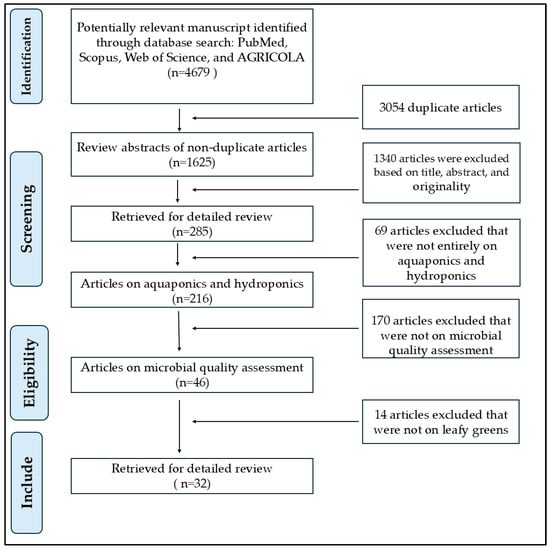
Figure 1
Open AccessArticle
Oral Fluid Sampling in Group-Housed Sows: Field Observations
by
Grzegorz Tarasiuk, Joseph F. Connor, Danyang Zhang and Jeffrey J. Zimmerman
Pathogens 2025, 14(9), 942; https://doi.org/10.3390/pathogens14090942 - 18 Sep 2025
Abstract
Oral fluid sampling is a well-established, non-invasive method for disease surveillance in growing pigs; however, its application in group-housed gestating sows is under-researched. This study (1) characterized sow behaviors associated with oral fluid sampling and (2) documented the transfer of an environmental target
[...] Read more.
Oral fluid sampling is a well-established, non-invasive method for disease surveillance in growing pigs; however, its application in group-housed gestating sows is under-researched. This study (1) characterized sow behaviors associated with oral fluid sampling and (2) documented the transfer of an environmental target into pen-based oral fluid samples. Field observations were conducted on a commercial sow farm in 12 pens of gestating sows sorted by parity (gilts, parity one, and multiparous sows). Sow oral fluid sampling behaviors were quantified by recording interactions with rope samplers using video cameras and then analyzing the recorded footage. All oral fluid sampling attempts were successful. Unlike growing pigs, experience with rope samplers (“training”) did not increase sow participation, but participation in oral fluid collection did increase as sampling time increased. The transfer of environmental components into oral fluid samples was demonstrated by introducing a fluorescent tracer into the pen and then detecting specific fluorescence in the samples (8 of 12 pens). These findings support the implementation of oral fluid sampling in group-housed sows and provide practical recommendations for optimizing surveillance protocols, including extended sampling times and use of at least two ropes per pen.
Full article
(This article belongs to the Special Issue Current Challenges in Veterinary Virology)
►▼
Show Figures
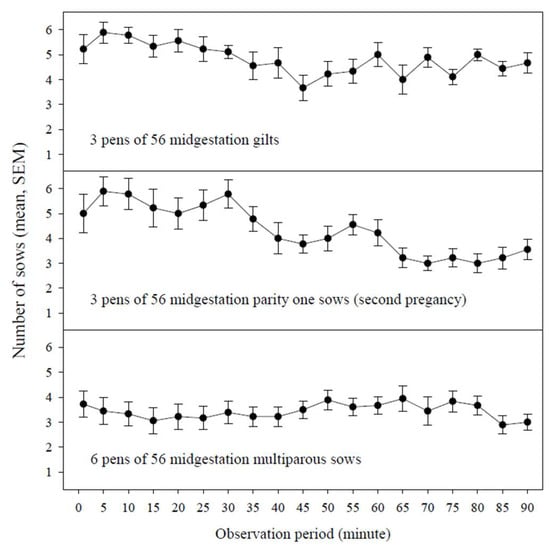
Figure 1
Open AccessArticle
Hepatitis C (HCV) and Hepatitis Delta (HDV) Viruses in a Teaching Hospital in Southern Italy: What Is the Epidemiological Situation in the Era of New Drugs?
by
Nadia Marascio, Grazia Pavia, Chiara Mazzei, Michele Manno, Giorgio Settimo Barreca, Cinzia Peronace, Carmela Ciurleo, Francesca Trimboli, Marta Pantanella, Angelo Giuseppe Lamberti, Giovanni Matera and Angela Quirino
Pathogens 2025, 14(9), 941; https://doi.org/10.3390/pathogens14090941 - 17 Sep 2025
Abstract
If the number of viral hepatitis infections is to be decreased worldwide, and the World Health Organization (WHO) elimination targets are to be achieved by 2030, this requires determining the burden of infection according to the WHO’s test-and-treat approach. In 2014, the introduction
[...] Read more.
If the number of viral hepatitis infections is to be decreased worldwide, and the World Health Organization (WHO) elimination targets are to be achieved by 2030, this requires determining the burden of infection according to the WHO’s test-and-treat approach. In 2014, the introduction of Direct-Acting Antivirals (DAAs) revolutionized the management of Hepatitis C Virus (HCV); another improvement came in 2020, when the use of bulevirtide (BLV) was authorized as a treatment for chronic Hepatitis D Virus (HDV) infection, showing good efficacy. The present observational study was carried out between 2019 and 2024. The diagnosis of viral hepatitis was carried out by routine assays. HDV typing was performed by Sanger sequencing and phylogenetic analysis. Overall, the HCV antibody prevalence was 3.4% in the studied time span, and it was higher in males than in females (59% vs. 41%). In viremic patients, HCV1b (33%) and HCV2a/2c (25%) were the most common subtypes. The overall HCV viremic rate declined in 2022 (2.8%). Unlike HCV, 71.4% of HDV viremic patients were females, and they had a median age of 58 years. The viral load of HDV RNA ranged from 20 IU/mL to 8 million IU/mL. Viral genotypes were classified as HDV1c and HDV1e. In this study, we highlight the prevalence of HCV/HDV infections and their genotype evolution in Southern Italy, underscoring the urgent need to enhance screening and linkage to care. Finally, we quantify the burden of active infections in order to provide data from real-life settings, and we describe the virological status of people living with HCV or HBV/HDV, who may experience significant benefits in terms of liver-related mortality after DAA or BLV treatment.
Full article
(This article belongs to the Special Issue Pathogenesis of Viral Hepatitis)
►▼
Show Figures
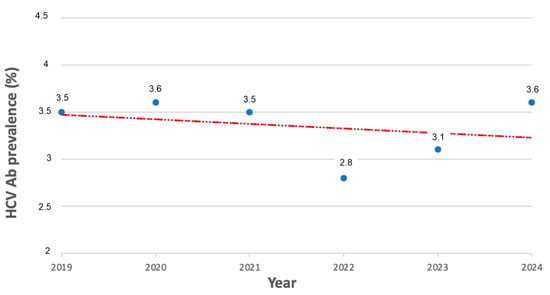
Figure 1
Open AccessArticle
Swine Practitioner Practices on Oral Fluid Sampling in U.S. Swine Farms: A Nationwide Survey
by
Xiaomei Yue, Mickey Leonard, Margret Tavai-Tuisalo’o, Sasidhar Malladi, Mariana Kikuti, Claudio Marcello Melini, Pam Zaabel, Marie R. Culhane and Cesar A. Corzo
Pathogens 2025, 14(9), 940; https://doi.org/10.3390/pathogens14090940 - 16 Sep 2025
Abstract
Oral fluid sampling has been widely adopted in swine health surveillance, offering an effective and cost-effective method for monitoring endemic and emerging diseases. This study characterized oral fluid sampling practices within U.S. pig production systems. An online questionnaire was conducted between June and
[...] Read more.
Oral fluid sampling has been widely adopted in swine health surveillance, offering an effective and cost-effective method for monitoring endemic and emerging diseases. This study characterized oral fluid sampling practices within U.S. pig production systems. An online questionnaire was conducted between June and October 2023, targeting swine practitioners, to collect data on implementation, usage, sampling protocols, and handling procedures. A total of 67 valid responses were received, representing an estimated 58M growing pigs and 3.9M sows. Nearly all respondents (99%) reported being familiar with or using oral fluid sampling for diagnostic purposes. The median of ropes hung per barn was two (interquartile range [IQR]: 1; 4), with 68% using one rope per two pens. The median of pens sampled per barn was six (IQR: 4; 10). Pigs typically accessed the rope for a median of 20 min (IQR: 17.5; 30). Sampling frequency varied by farm types. Half of gilt-development-unit (GDU) respondents collected samples monthly. When submitting samples to the veterinary diagnostic laboratories, pig age (91%) was the most frequently included information. This study reveals the widespread and varied adoption of oral fluid sampling, highlighting the need for standardized collection procedures to support consistent interpretation and improve reliability for detecting emerging pathogens.
Full article
(This article belongs to the Section Viral Pathogens)
►▼
Show Figures
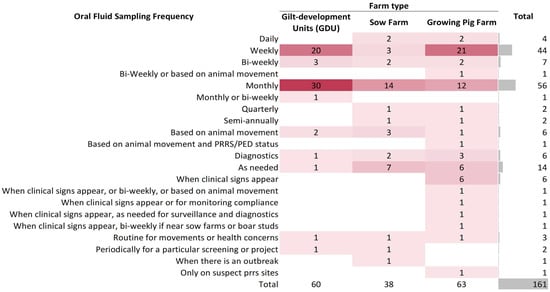
Figure 1
Open AccessReview
Flavescence Dorée and Grapevine Susceptibility: From Host–Pathogen Interaction to Cultivar Categorization
by
Alessandro Bene, Marzia Vergine, Athos Pedrelli, Luigi De Bellis and Andrea Luvisi
Pathogens 2025, 14(9), 939; https://doi.org/10.3390/pathogens14090939 - 16 Sep 2025
Abstract
►▼
Show Figures
Flavescence dorée (FD) is a major grapevine disease in Europe with significant economic consequences. The objective of this review is to provide as much information as possible on the documented susceptibility or tolerance of different cultivars, both international and local within individual countries.
[...] Read more.
Flavescence dorée (FD) is a major grapevine disease in Europe with significant economic consequences. The objective of this review is to provide as much information as possible on the documented susceptibility or tolerance of different cultivars, both international and local within individual countries. Additionally, spontaneous recovery has been observed as a viable option for replanting injured vines, but its efficacy varies by cultivars. In this regard, a broad categorization was developed for several cultivars, particularly those examined in Europe, describing their higher or lower susceptibility and aptitude to recover. Future research, however, should not only address the geographic spread of FD, but also investigate how pathogen–host interactions may differ across cultivars. Such insights could be crucial for assessing the risk of FD introduction in new regions and understanding cultivar-specific susceptibility and epidemic dynamics, because present studies remain mostly concentrated in regions suffering significant FD pressure, resulting in a focus on a small number of cultivars that are often specific to a certain geographical area. Furthermore, the implementation of innovative strategies has the potential to give a comprehensive and long-term approach to managing and containing FD.
Full article
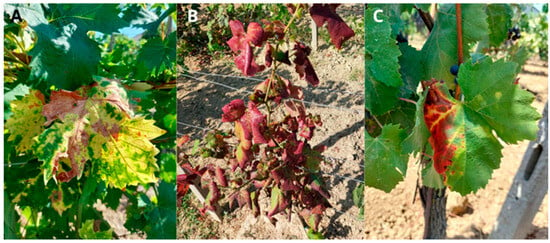
Figure 1
Open AccessSystematic Review
Global Research Trends on Major Pathogenic Enteric Viruses (1990–2024): A Bibliometric Analysis of Epidemiology, Transmission, and Public Health Impact
by
Mohammad Alotaibi, Hanan Al-Khalaifah and Assia Bouhoudan
Pathogens 2025, 14(9), 938; https://doi.org/10.3390/pathogens14090938 - 16 Sep 2025
Abstract
►▼
Show Figures
Pathogenic enteric viruses are a leading cause of gastroenteritis-related mortality worldwide. However, the architecture of this research field remains poorly quantified. This bibliometric analysis provides a comprehensive overview of 35 years of global scientific output on major enteric viruses, such as rotavirus, norovirus,
[...] Read more.
Pathogenic enteric viruses are a leading cause of gastroenteritis-related mortality worldwide. However, the architecture of this research field remains poorly quantified. This bibliometric analysis provides a comprehensive overview of 35 years of global scientific output on major enteric viruses, such as rotavirus, norovirus, astrovirus, sapovirus, and non-polio enteroviruses, to map trends, methodological developments, and geographic disparities. We conducted a systematic search of PubMed and Scopus (1990–2024), identifying 10,017 records. After deduplication and eligibility screening, a final corpus of 8320 publications was analyzed using Bibliometrix (Biblioshiny 5.0) in R (version 4.3.0) and VOSviewer (Version 1.6.20). We found that scientific production grew steadily (CAGR = 5.84%), reaching its peak in 2021. The field is characterized by profound thematic and geographic disparity: rotavirus dominated the literature (56.3% of publications), followed by norovirus (30.8%), while other viruses were severely underrepresented (<9% each). Geographically, output was highly concentrated, with the top five countries (the USA, China, Japan, India, and Brazil) producing 92.4% of the publications. In contrast, high-burden regions, such as sub-Saharan Africa and Latin America, contributed only 7.6%. Genomic sequencing gained prominence, being cited in over 26.2% of publications from 2020 to 2024, reflecting a methodological shift accelerated by the application of wastewater-based epidemiology during the COVID-19 pandemic. In conclusion, while genomic tools and environmental monitoring are transforming enteric virus research, its progress is hampered by deep and persistent inequalities. These include a narrow focus on rotavirus and a significant disparity between regions with high disease burdens and those with high research outputs. Closing this gap requires targeted investments in equitable collaboration, local genomic capacity, and integrated public health interventions combining vaccination, WASH, and One Health strategies.
Full article

Figure 1
Open AccessReview
The Role of Artificial Intelligence in Herpesvirus Detection, Transmission, and Predictive Modeling: With a Special Focus on Marek’s Disease Virus
by
Haji Akbar
Pathogens 2025, 14(9), 937; https://doi.org/10.3390/pathogens14090937 - 16 Sep 2025
Abstract
Herpesvirus infections, including herpes simplex virus (HSV), Epstein–Barr virus (EBV), and cytomegalovirus (CMV), present significant challenges in diagnosis, treatment, and transmission control. Despite advances in medical technology, managing these infections remains complex due to the viruses’ ability to establish latency and their widespread
[...] Read more.
Herpesvirus infections, including herpes simplex virus (HSV), Epstein–Barr virus (EBV), and cytomegalovirus (CMV), present significant challenges in diagnosis, treatment, and transmission control. Despite advances in medical technology, managing these infections remains complex due to the viruses’ ability to establish latency and their widespread prevalence. Artificial Intelligence (AI) has emerged as a transformative tool in biomedical science, enhancing our ability to understand, predict, and manage infectious diseases. In veterinary virology, AI applications offer considerable potential for improving diagnostics, forecasting outbreaks, and implementing targeted control strategies. This review explores the growing role of AI in advancing our understanding of herpesvirus infection, particularly those caused by MDV, through improved detection, transmission modeling, treatment strategies, and predictive tools. Employing AI technologies such as machine learning (ML), deep learning (DL), and natural language processing (NLP), researchers have made significant progress in addressing diagnostic limitations, modeling transmission dynamics, and identifying potential therapeutics. Furthermore, AI holds the potential to revolutionize personalized medicine, predictive analytics, and vaccine development for herpesvirus-related diseases. The review concludes by discussing ethical considerations, implementation challenges, and future research directions necessary to fully integrate AI into clinical and veterinary practice.
Full article
(This article belongs to the Section Viral Pathogens)
►▼
Show Figures
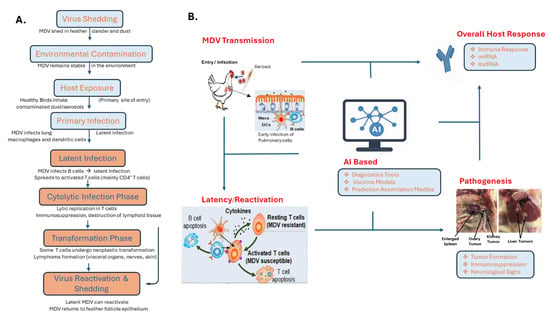
Figure 1
Open AccessArticle
Pangenomic Characterization of Campylobacter Plasmids for Enhanced Molecular Typing, Risk Assessment and Source Attribution
by
Lucas Harrison, Sampa Mukherjee, Cong Li, Shenia Young, Qijing Zhang and Shaohua Zhao
Pathogens 2025, 14(9), 936; https://doi.org/10.3390/pathogens14090936 - 16 Sep 2025
Abstract
Plasmid-mediated dissemination of antimicrobial resistance (AMR) and virulence genes plays a critical role in enhancing the adaptive potential of Campylobacter spp. While Campylobacter plasmids of concern are commonly classified as pTet, pVir, pCC42 or a large plasmid encoding a T6SS (pT6SS), existing classification
[...] Read more.
Plasmid-mediated dissemination of antimicrobial resistance (AMR) and virulence genes plays a critical role in enhancing the adaptive potential of Campylobacter spp. While Campylobacter plasmids of concern are commonly classified as pTet, pVir, pCC42 or a large plasmid encoding a T6SS (pT6SS), existing classification systems often lack the resolution to capture intra-group diversity. Here we demonstrate a plasmid typing approach with enhanced discriminatory power that categorizes these major plasmid groups into discrete subgroups and strengthens risk-assessment investigations. Pangenomic analysis of 424 Campylobacter plasmid sequences revealed 30 distinct plasmid groups. The four major groups above accounted for 74.3% of the dataset. Within these major groups, 177 plasmid type-specific loci were used to define 16 subgroups. pTet plasmids were subdivided into 5 subgroups, with subgroup 3 enriched in C. coli. pVir plasmids formed 3 subgroups, with only subgroup 3 harboring the tet(O) genes. The 5 pCC42 subgroups displayed Campylobacter species specificity while the 3 pT6SS subgroups encoded distinct AMR profiles. This high-resolution typing approach provides a unified and scalable method to characterize Campylobacter plasmid diversity and identifies genetic markers critical for pathogen surveillance, source attribution and mitigation strategies employed to safeguard human and animal health.
Full article
(This article belongs to the Section Bacterial Pathogens)
►▼
Show Figures
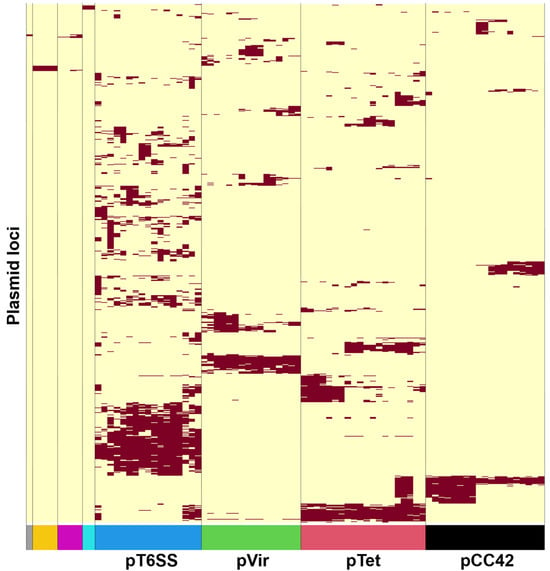
Figure 1
Open AccessArticle
Exploring the Virome of Nile Tilapia (Oreochromis niloticus) Using Metagenomic Analysis
by
Amira Ezzat, Ahmed Abd El Wahed, Arianna Ceruti, Amel M. El Asely, Mohamed Shawky Khalifa, Andrew D. Winters, Uwe Truyen, Adel A. Shaheen and Mohamed Faisal
Pathogens 2025, 14(9), 935; https://doi.org/10.3390/pathogens14090935 - 16 Sep 2025
Abstract
Nile tilapia (Oreochromis niloticus) is an indispensable source of high-quality protein worldwide. Along with the exponential expansion of tilapia aquaculture, several novel pathogenic viruses have emerged, and some cause significant economic losses. Unfortunately, there is scarce information on the biology and
[...] Read more.
Nile tilapia (Oreochromis niloticus) is an indispensable source of high-quality protein worldwide. Along with the exponential expansion of tilapia aquaculture, several novel pathogenic viruses have emerged, and some cause significant economic losses. Unfortunately, there is scarce information on the biology and epidemiology of these viruses. This exploratory metagenomic study used Oxford Nanopore Technology (ONT) sequencing to profile the virome compositions of both wild and farmed Nile tilapia across five regions in Egypt. The Nile tilapia virome was dominated by two double-stranded DNA bacteriophages, Muvirus mu and M. sfmu, which constituted 79.8% of the detected sequences. Eukaryotic viruses, including members of the families Amnoonviridae, Peribunyaviridae, and Baculoviridae, were also identified. Two giant DNA viruses known to infect Acanthamoeba spp., Mollivirus sp., and Pandoravirus sp. were identified in the spleen virome of tilapia from a single sampling site. The diversity analysis showed no significant differences among tissue types or sampling sites. Phylogenetic analyses were performed on a single virus detected of potential pathogenicity, an amnoonvirus. The analyses demonstrated that the detected virus is a member of the family Amnoonviridae and placed it alongside members of the Tilapinevirus genus. The virus, however, was distinct from the other two members in the genus: T. tilapae and T. poikilos. This study underscores the usefulness of ONT in providing a foundational understanding of the Nile tilapia virome.
Full article
(This article belongs to the Special Issue Virus–Host Cell Interactions and Research of New Antivirals)
►▼
Show Figures

Figure 1
Open AccessArticle
Active Surveillance and Farm-Level Risk Evaluation of African Swine Fever in Southern Nigeria
by
Alhaji S. Olono, Olusola A. Ogunsanya, Ayotunde E. Sijuwola, Femi M. Saibu, Oluwatobi Adedokun, Akeemat O. Ayinla, John Fadele, Harouna Soumare, Eugenie Y. Tchokote, John O. Abiola, Bonto Faburay, Corrie Brown, Christian T. Happi and Anise N. Happi
Pathogens 2025, 14(9), 934; https://doi.org/10.3390/pathogens14090934 - 16 Sep 2025
Abstract
Pig farms in Southern Nigeria face recurrent threats from enzootic viral infections, yet active surveillance remains limited. This study implemented an active surveillance approach targeting African swine fever virus (ASFV) to assess its circulation across four states. We sampled 40 pig farms and
[...] Read more.
Pig farms in Southern Nigeria face recurrent threats from enzootic viral infections, yet active surveillance remains limited. This study implemented an active surveillance approach targeting African swine fever virus (ASFV) to assess its circulation across four states. We sampled 40 pig farms and two abattoirs, collecting swine blood and ticks for molecular and serological analysis. Sampling was conducted during both African swine fever (ASF) outbreak (n = 27 pigs) and non-outbreak (n = 204 pigs) periods, resulting in 231 samples tested for ASFV DNA. Additionally, 46 plasma samples from the non-outbreak period were screened for ASFV-specific antibodies. ASFV was detected in all pigs sampled during outbreak periods (27/27; 100%), whereas none of the pigs sampled during non-outbreak periods tested positive (0/204). Of the 27 positives, sequencing generated 7 genomes characterized as genotype II. Serological testing of the 46 plasma samples from non-outbreak pigs revealed no ASFV seropositivity. All tick samples were negative for ASFV DNA. Farm-level risk evaluations revealed widespread biosecurity lapses, suggesting these deficiencies as potential drivers of ASFV circulation. These findings underscore the urgent need to strengthen farm-level biosecurity and demonstrate the pivotal role of active surveillance and genome sequencing in detecting and characterizing ASF outbreaks.
Full article
(This article belongs to the Section Viral Pathogens)
►▼
Show Figures
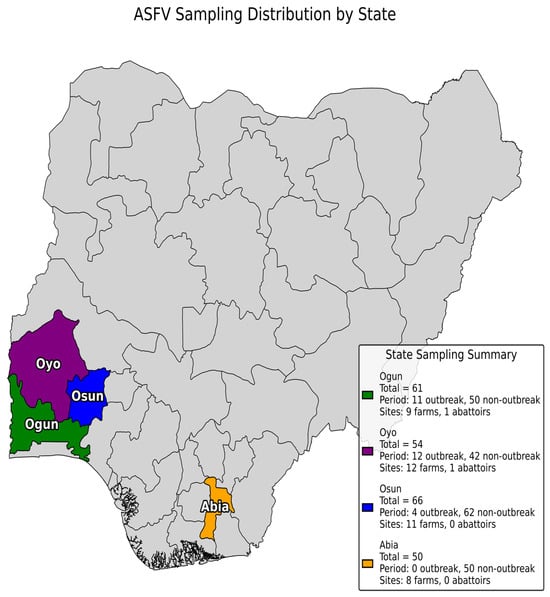
Figure 1
Open AccessArticle
Simulating the Spread of Foot-and-Mouth Disease in Densely Populated Areas as Part of Contingency Plans to Establish the Best Control Options
by
Silvia Bellini, Alessandra Scaburri, Marco Tironi, Veronica Cappa, Alessandro Mannelli and Giovanni Loris Alborali
Pathogens 2025, 14(9), 933; https://doi.org/10.3390/pathogens14090933 - 16 Sep 2025
Abstract
Foot-and-mouth disease (FMD) is a highly contagious disease of livestock caused by the FMD virus (FMDV). It is not dangerous to humans but can cause severe disruption to the farming sector and hampers trade in animals and animal products. Given the characteristic of
[...] Read more.
Foot-and-mouth disease (FMD) is a highly contagious disease of livestock caused by the FMD virus (FMDV). It is not dangerous to humans but can cause severe disruption to the farming sector and hampers trade in animals and animal products. Given the characteristic of transmissibility of the virus, the legislation in force in the European Union requires that some control activities be initiated in peacetime: the so-called “emergency preparedness”. As part of a research project on FMD, a dynamic transmission model was developed to test the effectiveness of the main control strategies in different livestock settings in Italy. This manuscript focuses on the control of the disease in densely populated livestock areas (DPLAs). Reduction in farm density was simulated to identify a threshold density compatible with disease control in the study area and to understand whether this was acceptable in terms of the sustainability of the livestock production system. Considering that in some municipalities the density of animals greatly exceeded the identified threshold, we adopted an original risk-based approach aimed at identifying farms which were most likely to play a central role in FMDV transmission. This approach has proven to be the most effective in controlling the spread of FMDV and can be proposed for practical applications where limited information on contacts between farms is available.
Full article
(This article belongs to the Special Issue New Insights into Viral Infections of Domestic Animals)
►▼
Show Figures

Figure 1
Open AccessReview
Update on Ophthalmic Implications of Highly Pathogenic Avian Influenza A (H5N1) Virus
by
Timothy Kaftan, Nam V. Nguyen, Jack Begley, Tolulope Fashina, Jessica Carag and Steven Yeh
Pathogens 2025, 14(9), 932; https://doi.org/10.3390/pathogens14090932 - 16 Sep 2025
Abstract
Introduction: Highly Pathogenic Avian Influenza (HPAI) A(H5N1) represents a growing public health challenge, given broadening zoonotic vectors, with a previously reported human mortality rate of roughly 50%. Late March 2024 marked the start of a new outbreak of HPAI A(H5N1) in the United
[...] Read more.
Introduction: Highly Pathogenic Avian Influenza (HPAI) A(H5N1) represents a growing public health challenge, given broadening zoonotic vectors, with a previously reported human mortality rate of roughly 50%. Late March 2024 marked the start of a new outbreak of HPAI A(H5N1) in the United States. While offering unique public health challenges, this outbreak also provides insight into clinical presentation and ocular involvement implications, transmission vectors, and the implementation of successful surveillance strategies. Objectives: This review seeks to highlight current and historical outbreak trends, transmission and ocular tropism significance, and strategies to mitigate viral spread. Methods: A comprehensive narrative literature review was completed using PubMed database as well as local, federal, and international public health press releases. Discussion: The 2024 US outbreak of H5N1 demonstrates the unique adaptability of the virus. Traditionally transmitted to humans via infected poultry, this outbreak marks the first confirmed case of dairy cow-transmitted human infection. Unlike many past H5N1outbreaks, the majority of patients in the current US outbreak have presented with conjunctivitis either alone or alongside systemic symptoms. This ocular-specific disease manifestation offers new clinical and screening implications. Awareness of ophthalmic involvement among physicians and public health organizations can help guide screening candidates and identify potential infections.
Full article
(This article belongs to the Section Viral Pathogens)
►▼
Show Figures
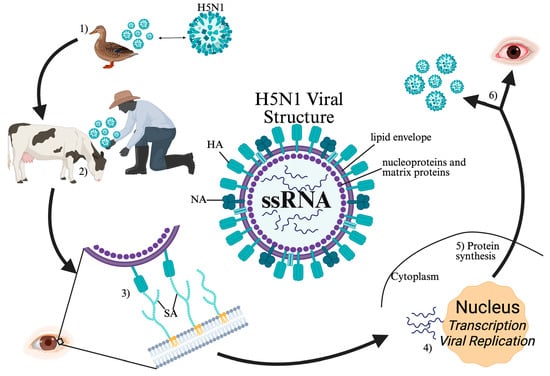
Figure 1
Open AccessCase Report
Unusual Localization of Presumptive Sarcina ventriculi in the Terminal Ileum: A Case Report
by
Dua Abuquteish, Daifallah AlNawawi, Reza Khorvash, Osama M. Abu Ata and Nidal Almasri
Pathogens 2025, 14(9), 931; https://doi.org/10.3390/pathogens14090931 - 16 Sep 2025
Abstract
►▼
Show Figures
Background: Sarcina ventriculi is a bacterium predominantly reported in the stomach and associated with emphysematous gastritis, delayed gastric emptying, gastroparesis, or gastric outlet obstruction. Its prevalence is increasing among patients with a history of organ transplants, immunosuppression, and graft-versus-host disease (GVHD). This bacterium
[...] Read more.
Background: Sarcina ventriculi is a bacterium predominantly reported in the stomach and associated with emphysematous gastritis, delayed gastric emptying, gastroparesis, or gastric outlet obstruction. Its prevalence is increasing among patients with a history of organ transplants, immunosuppression, and graft-versus-host disease (GVHD). This bacterium can be detected on histology with characteristic tetrad packet morphology; however, confirmation requires PCR and molecular studies. The role of Sarcina ventriculi in human diseases is not fully understood and has unclear clinical significance. While certain studies point to a possible pathogenic role, others regard its detection as incidental with no clear clinical consequence. Case presentation: Herein, we report a case of a 39-year-old male patient with primary refractory cHL, stage IVb, who underwent an autologous bone marrow transplant (BMT) and an allogeneic stem cell infusion. His post-transplant course was complicated by chronic kidney disease (CKD), malnutrition, depression, myopathy, skin, and colon GVHD. He eventually developed sepsis, was admitted to the ICU and developed multiorgan failure and passed away. The patient developed diarrhea, and the gastrointestinal specialist was consulted and revealed ulcerated ileitis and colitis. Biopsies were taken to evaluate for CMV infection and GVHD. The terminal ileum biopsy mainly revealed ulceration with granulation tissue formation and abundant microorganisms arranged in distinctive tetrads, characteristic of Sarcina ventriculi. The colonic biopsies were consistent with GVHD grade II. Conclusions: The significance of Sarcina microorganisms and their mechanisms of injury remain poorly understood. The identification of Sarcina ventriculi in the terminal ileum, which is an unusual and previously unreported finding, adds a new perspective to our understanding of its pathogenic potential and anatomical distribution. While the patient’s clinical decline was influenced by multiple factors, including GVHD, recurrent sepsis, and multiorgan failure, the role of Sarcina ventriculi as a potential exacerbating factor remains unclear.
Full article
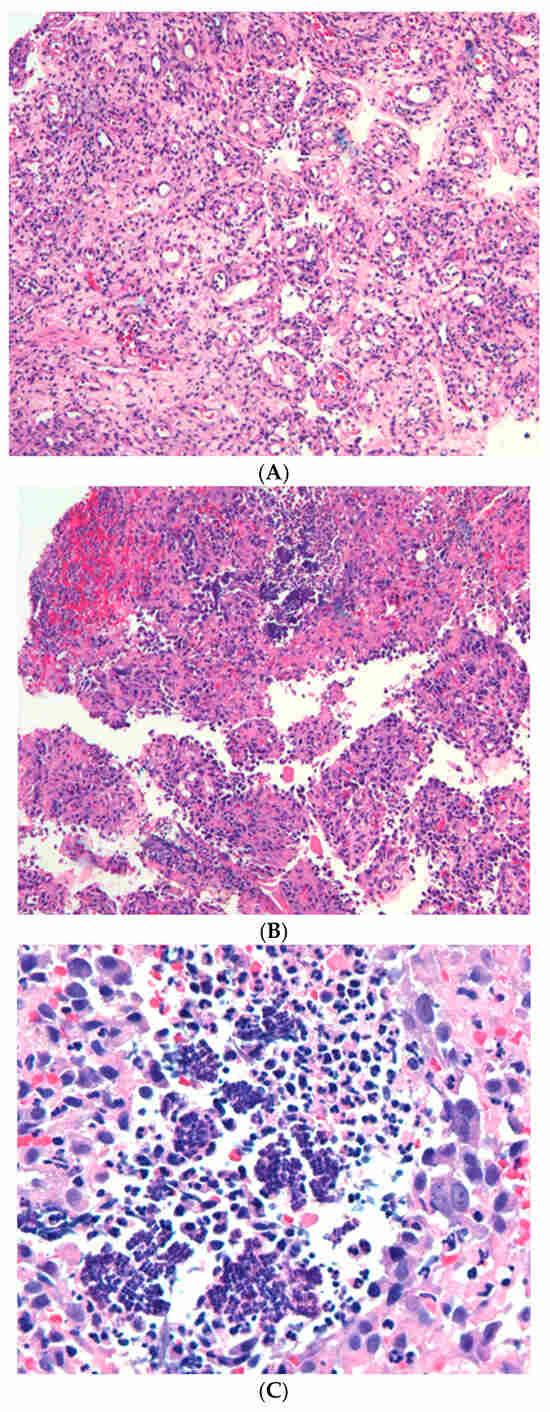
Figure 1

Journal Menu
► ▼ Journal Menu-
- Pathogens Home
- Aims & Scope
- Editorial Board
- Reviewer Board
- Topical Advisory Panel
- Instructions for Authors
- Special Issues
- Topics
- Sections & Collections
- Article Processing Charge
- Indexing & Archiving
- Editor’s Choice Articles
- Most Cited & Viewed
- Journal Statistics
- Journal History
- Journal Awards
- Conferences
- Editorial Office
Journal Browser
► ▼ Journal BrowserHighly Accessed Articles
Latest Books
E-Mail Alert
News
19 September 2025
MDPI Webinar | The Science Behind the Prize: 2025 Nobel Physiology or Medicine Roundtable, 6 October 2025
MDPI Webinar | The Science Behind the Prize: 2025 Nobel Physiology or Medicine Roundtable, 6 October 2025

3 September 2025
Join Us at the MDPI at the University of Toronto Career Fair, 23 September 2025, Toronto, ON, Canada
Join Us at the MDPI at the University of Toronto Career Fair, 23 September 2025, Toronto, ON, Canada

Topics
Topic in
Animals, Pathogens, Veterinary Sciences, Zoonotic Diseases
Zoonotic Vector-Borne Diseases of Companion Animals
Topic Editors: Anastasia Diakou, Donato TraversaDeadline: 30 September 2025
Topic in
Infectious Disease Reports, Insects, IJERPH, Pathogens, TropicalMed, Zoonotic Diseases
Vector-Borne Disease Spatial Epidemiology, Disease Ecology, and Zoonoses
Topic Editors: Chad L. Cross, Louisa Alexandra MessengerDeadline: 31 December 2025
Topic in
Animals, Arthropoda, Diversity, Insects, Life, Pathogens
Arthropod Biodiversity: Ecological and Functional Aspects, 2nd Edition
Topic Editors: Paolo Solari, Roberto M. Crnjar, Anita Giglio, Gianluca TettamantiDeadline: 31 January 2026
Topic in
Animals, Arthropoda, Insects, Vaccines, Veterinary Sciences, Pathogens
Ticks and Tick-Borne Pathogens: 2nd Edition
Topic Editors: Alina Rodriguez-Mallon, Alejandro Cabezas-CruzDeadline: 31 March 2026

Conferences
Special Issues
Special Issue in
Pathogens
Human Papillomavirus Infection and Vaccine Research
Guest Editor: Yao-Min HungDeadline: 27 September 2025
Special Issue in
Pathogens
Ticks and Tick-Borne Pathogens in a Changing World
Guest Editors: Roxanne A. Charles, Sebastián Muñoz-LealDeadline: 30 September 2025
Special Issue in
Pathogens
Feature Papers on the Epidemiology of Infectious Diseases
Guest Editors: Gunjan Arora, Jiří Černý, Yongguo Cao, Ankur BothraDeadline: 30 September 2025
Special Issue in
Pathogens
Updates in Infective Endocarditis—2nd Edition
Guest Editors: Hussam Tabaja, Jack McHughDeadline: 30 September 2025
Topical Collections
Topical Collection in
Pathogens
Advances in Tick Research
Collection Editors: Alejandro Cabezas-Cruz, Ladislav Šimo, James J. Valdés, Dasiel Obregón
Topical Collection in
Pathogens
Pathology and Parasitic Diseases of Animals
Collection Editors: Stefania Perrucci, Livio Galosi, Giacomo Rossi
Topical Collection in
Pathogens
Current Status of Research on Gut Metabolites and Microbiota
Collection Editor: Ana Elena Pérez Cobas








